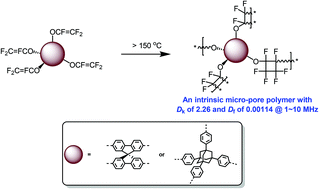Understanding how intrinsic micro-pores affect the dielectric properties of polymers: an approach to synthesize ultra-low dielectric polymers with bulky tetrahedral units as cores†
Abstract
Two fluoro-containing low dielectric polymers have been successfully prepared based on thermo-crosslinkable trifluorovinyl ether (TFVE) monomers with big tetrahedral units (adamantane and spirobifluorene). These polymers exhibit an average dielectric constant (Dk) of lower than 2.6, and the polymer with adamantane units displays the lowest Dk of 2.26 and an average dielectric loss (Df) of 1.14 × 10−3 at a range of frequencies from 1 to 10 MHz. In contrast, the polymer with spirobifluorene units displays a Dk of 2.54 and a Df of 1.53 × 10−3. Such results are attributed to the existence of intrinsic micropores produced by the big adamantane and spirobifluorene units in the polymers. Positron annihilation lifetime spectroscopy (PALS) indicates two different micropores in both the polymers, with sizes of 2.354/4.354 and 2.949/4.408 Å, respectively. Because the polymer with adamantane units possesses bigger pore sizes, it shows a lower dielectric constant. These data mean that the polymer with adamantane units is suitable for use as encapsulation resins of integrated circuit (IC) dies for applications in the microelectronics industry.



 Please wait while we load your content...
Please wait while we load your content...